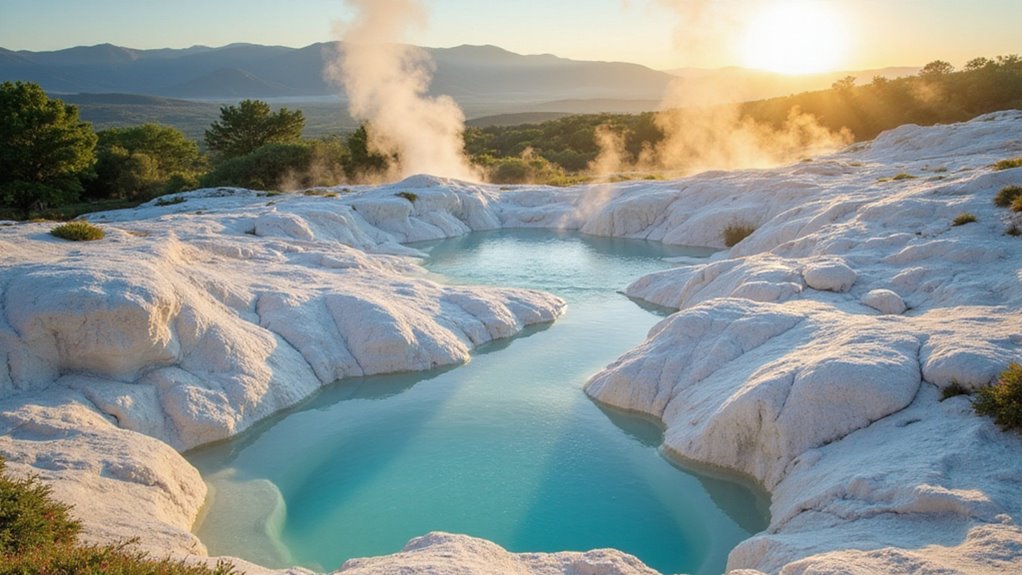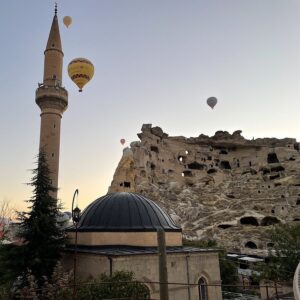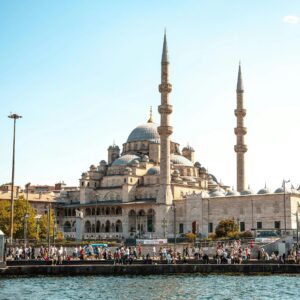Pamukkale’s thermal pools dazzle with white travertine terraces and mineral-rich waters, perfect for relaxation and healing. Visit April–June or September–October for mild weather and fewer crowds, avoiding July’s scorching heat. Entry costs 400 TL, granting access to the pools and ancient Hierapolis ruins. Pack a swimsuit, quick-dry clothes, and sturdy sandals for the slippery terrain. Soak in the warm, therapeutic waters, explore Roman ruins, and witness stunning sunsets—discover even more insider tips ahead.
Key Takeaways
- Pamukkale’s thermal pools feature white travertine terraces formed by calcium-rich springs, offering stunning natural beauty and healing properties.
- Best visiting months are April-June and September-October for mild weather, fewer crowds, and optimal pool conditions.
- Entrance fees are 400 TL for adults and 200 TL for children, granting access to the pools and the ancient city of Hierapolis.
- The thermal waters, rich in minerals like calcium and magnesium, relieve muscle aches, improve circulation, and rejuvenate the skin.
- Nearby attractions include Hierapolis ruins, Karahayıt’s colorful terraces, and local markets for traditional Turkish cuisine.
History and Formation of Pamukkale
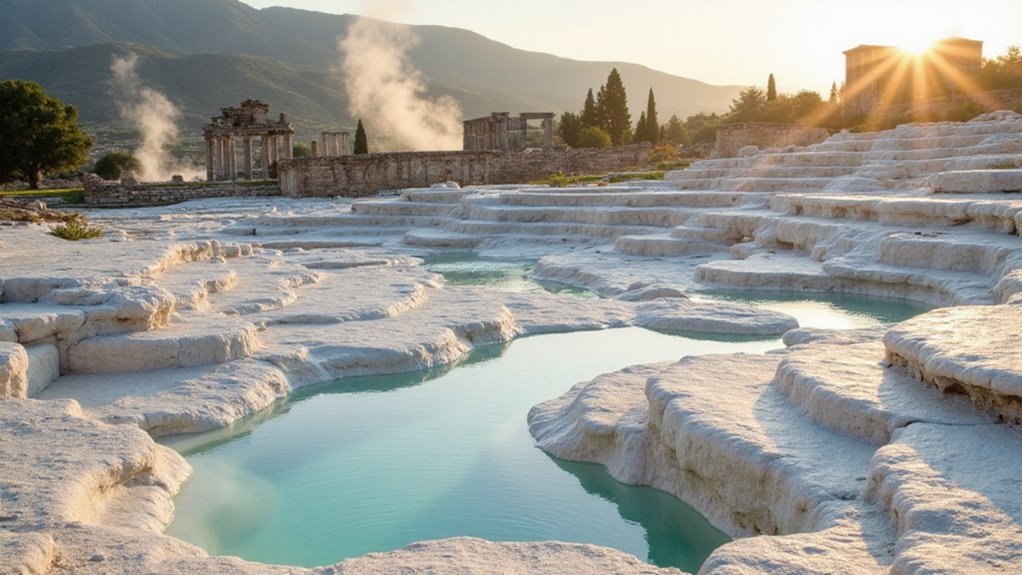
Though formed over thousands of years, Pamukkale’s dazzling white terraces still look otherworldly today. Ancient civilizations, like the Romans, recognized the geological significance of this natural wonder, building the nearby city of Hierapolis to harness its healing thermal waters. A full day tour from Istanbul allows you to explore these ancient ruins and travertine pools in comfort.
You’ll marvel at how calcium-rich springs cascaded over cliffs, creating travertine terraces that gleam like snow under the sun. These pools, shaped by nature’s artistry, have drawn travelers for centuries, offering both beauty and rejuvenation.
As you explore, you’ll feel the weight of history in every step, from the ruins of ancient baths to the remnants of temples. The thermal waters, rich in minerals, continue to flow, inviting you to soak in their warmth.
Pamukkale’s unique landscape, a blend of natural and human history, reminds you of the earth’s enduring power. It’s a place where you can connect with the past while embracing the freedom to wander and wonder. Visitors can also swim in Cleopatra’s Antique Pool, where submerged Roman columns add to the mystical experience.
Best Time to Visit the Thermal Pools
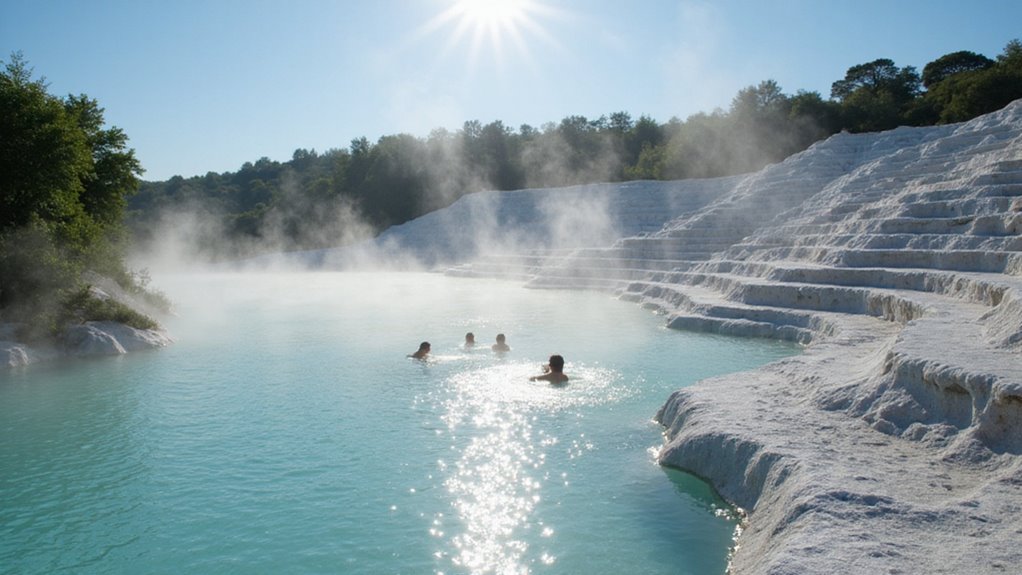
When is the ideal time to experience the enchanting Pamukkale Thermal Pools? The best months are April to June and September to October, when the weather patterns are mild and crowds are thinner.
For the ultimate Pamukkale experience, visit April to June or September to October for mild weather and fewer crowds.
Avoid peak seasons like July and August, when scorching heat and tourist surges can dampen your visit. Spring offers blooming landscapes, while autumn bathes the terraces in golden hues, creating a magical backdrop.
Winter, though cooler, provides serene moments with fewer visitors, but some pools may feel chilly. Pamukkale’s thermal waters remain inviting year-round, but timing your trip guarantees comfort and freedom to explore. Consider visiting during the Full Day Pamukkale Tour for a comprehensive experience that includes both the thermal pools and the ancient ruins of Hierapolis.
Mornings and late afternoons are perfect for soaking, as the light enhances the pools’ milky beauty. Check local forecasts to avoid unexpected rain, which can alter the experience. Don’t miss the chance to explore the nearby UNESCO World Heritage Site of Hierapolis, which complements the thermal pool experience. Plan wisely, and you’ll savor Pamukkale’s wonders at their finest.
How to Get to Pamukkale
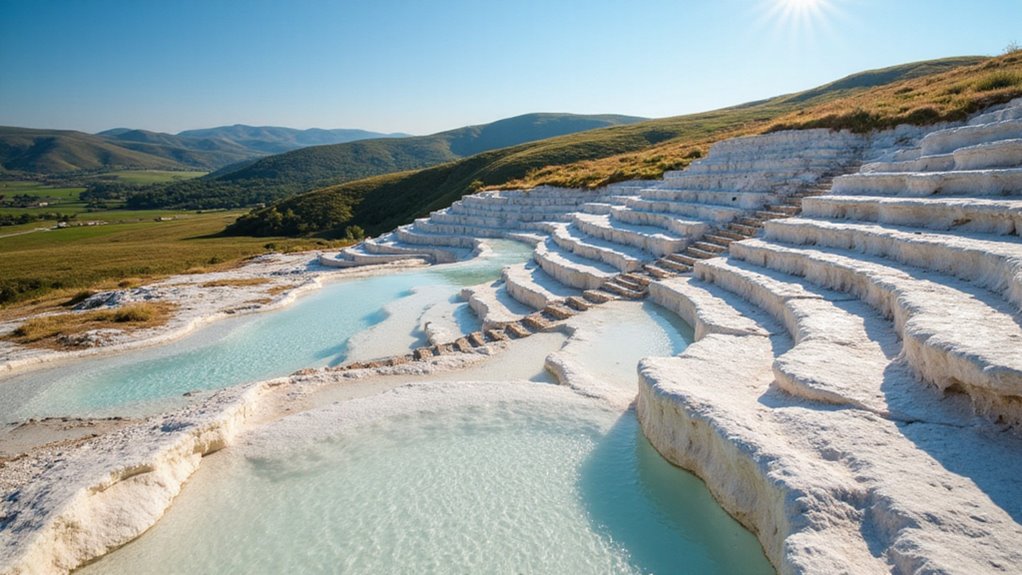
How can you reach the breathtaking Pamukkale Thermal Pools? You’ve got plenty of transportation options, each offering unique scenic routes to this natural wonder.
From Denizli, the nearest city, hop on a 20-minute bus or dolmuş (shared taxi) ride through rolling hills dotted with olive groves.
If you’re coming from Istanbul or Antalya, catch a domestic flight to Denizli Çardak Airport, then enjoy a 45-minute drive past cotton fields and vineyards. Many travelers combine this visit with a 2-day tour that includes Ephesus and Pamukkale for a seamless experience.
Prefer the open road? Rent a car and cruise along the D320 highway, where turquoise travertines emerge like a mirage.
For adventure seekers, overnight buses from major cities like Izmir or Cappadocia wind through moonlit valleys, arriving at dawn.
Trains from Izmir or Ankara offer a slower but picturesque journey through the Aegean countryside.
Whichever route you choose, the journey itself becomes part of the magic, building anticipation for those gleaming white terraces. Along the way, you’ll pass historical structures that hint at the region’s rich past, including the ancient city of Hierapolis.
Entrance Fees and Visiting Hours
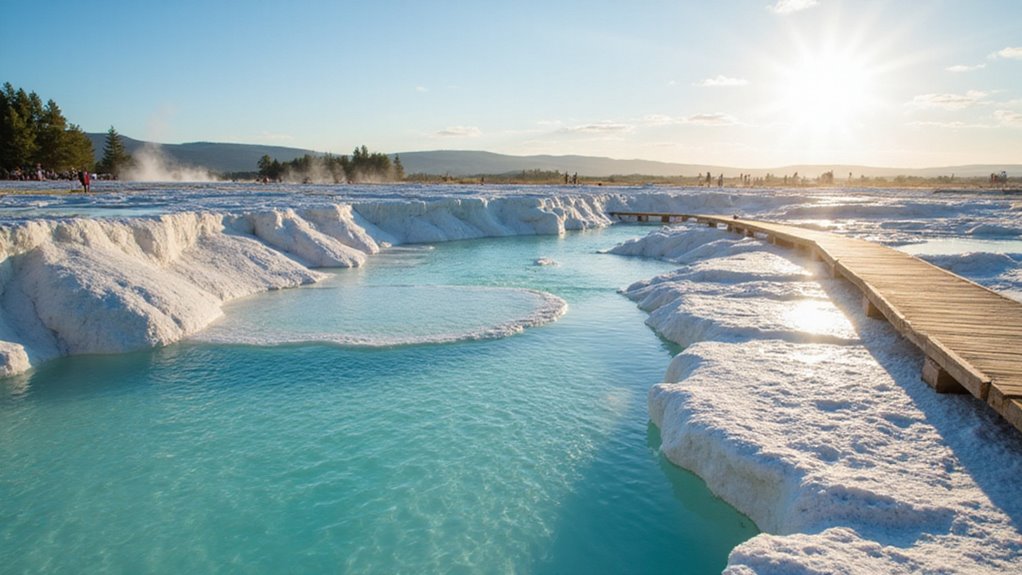
The Pamukkale Thermal Pools welcome visitors year-round, offering a chance to soak in their mineral-rich waters amidst stunning travertine terraces.
Experience year-round relaxation in Pamukkale’s mineral-rich thermal pools, surrounded by breathtaking travertine terraces.
Entrance fees are affordable, with tickets priced at 400 TL for adults and 200 TL for children, granting access to both the pools and the ancient city of Hierapolis.
Visiting hours vary by season, with the site open from 6:30 AM to 8:00 PM in summer and 8:00 AM to 5:00 PM in winter, ensuring flexibility for your schedule.
Early mornings or late afternoons are ideal for avoiding crowds and capturing the best light for photos.
You’ll find ticket booths at the main entrance, and online booking options are available for added convenience.
Remember, the pools are a protected UNESCO World Heritage Site, so respect the rules to preserve their natural beauty.
Plan your visit wisely to fully enjoy this breathtaking destination and consider combining your trip with a tour of the nearby ancient city of Hierapolis for a deeper historical experience.
What to Pack for Your Visit
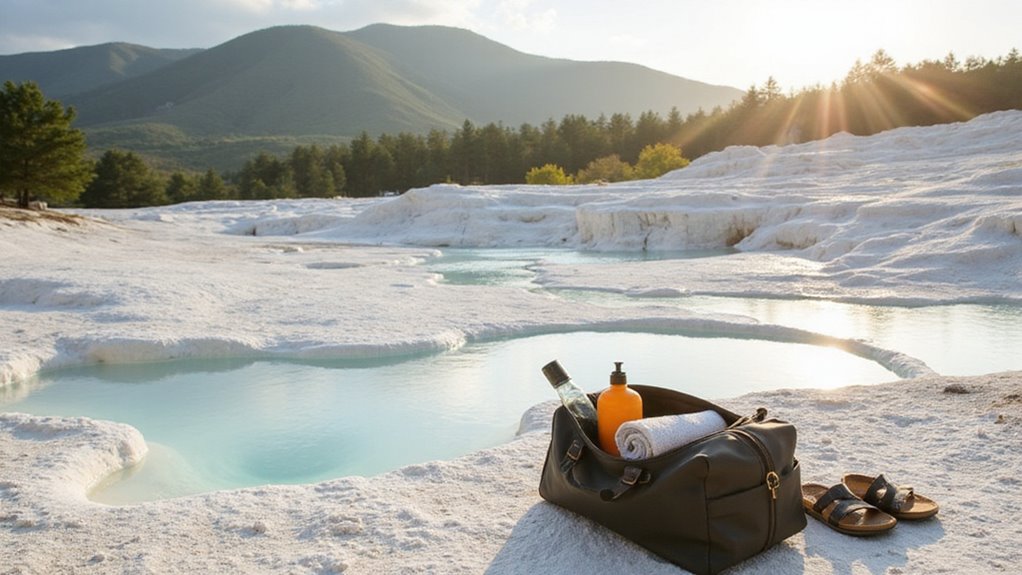
Ever wondered what essentials you’ll need for a seamless day at Pamukkale’s dazzling thermal pools?
Start with what to wear: a swimsuit, as the pools are the main attraction, and quick-dry clothing for comfort. Lightweight, breathable fabrics work best under the sun.
Pack a wide-brimmed hat and sunglasses to shield your eyes from the bright white travertines. For footwear, choose waterproof sandals with grip—the limestone can be slippery when wet.
Don’t forget essential gear like a reusable water bottle to stay hydrated and a waterproof bag for valuables. Sunscreen is a must; the reflective surfaces intensify UV rays. If you’re also visiting historical sites like Ephesus or Cappadocia, sunscreen will be equally vital for outdoor exploration.
Bring a microfiber towel for drying off quickly. A camera or phone with a waterproof case will capture the surreal beauty without damage.
Pamukkale’s pools demand practicality, so prioritize comfort and protection. With these items, you’ll savor every moment in this UNESCO World Heritage Site, free to explore without hassle.
Top Things to Do in Pamukkale
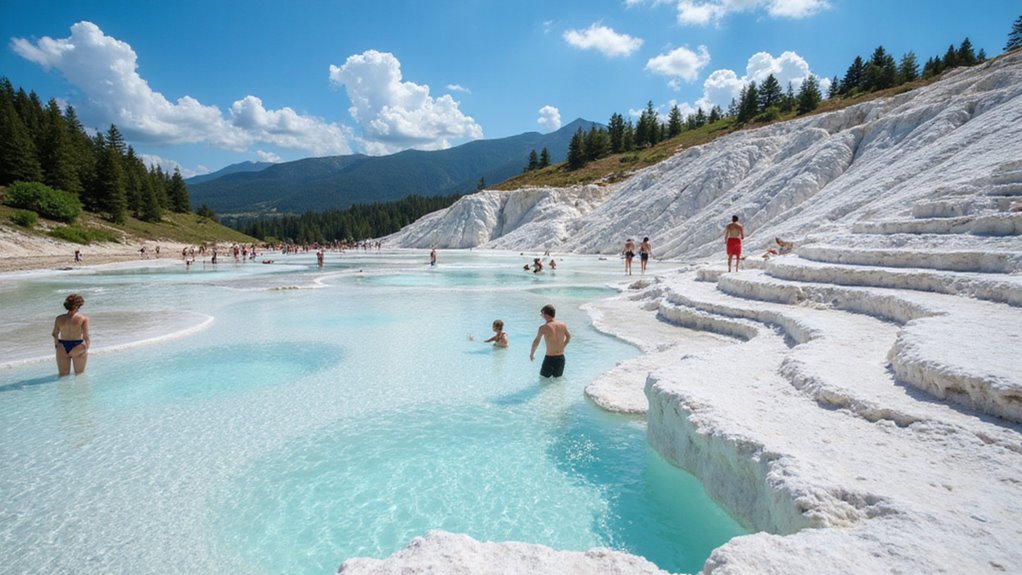
Pamukkale’s surreal landscape offers more than just its iconic thermal pools—you’ll find ancient ruins, rejuvenating spas, and breathtaking viewpoints.
Start by soaking in the milky-white travertines, where warm mineral-rich waters soothe your muscles. Capture stunning thermal photography at sunrise, when the pools glow in golden hues.
Explore Hierapolis, an ancient Roman city with a well-preserved theater, necropolis, and sacred springs. Immerse yourself in cultural experiences at the Antique Pool, swimming among submerged marble columns.
Hike to the top of the terraces for panoramic views of the cotton-white cascades. Visit Cleopatra’s Pool, where legend says the queen herself bathed. Learn about the Seven Wonders of the ancient world, including the nearby Temple of Artemis in Ephesus.
Pamukkale’s spas offer mud treatments and massages, perfect for post-exploration relaxation. Stroll through the nearby village to sample local cuisine and handmade crafts.
Don’t miss the sunset from the terraces, a magical moment you’ll remember forever. Every corner of Pamukkale invites you to unwind, explore, and connect with history.
Nearby Attractions to Explore
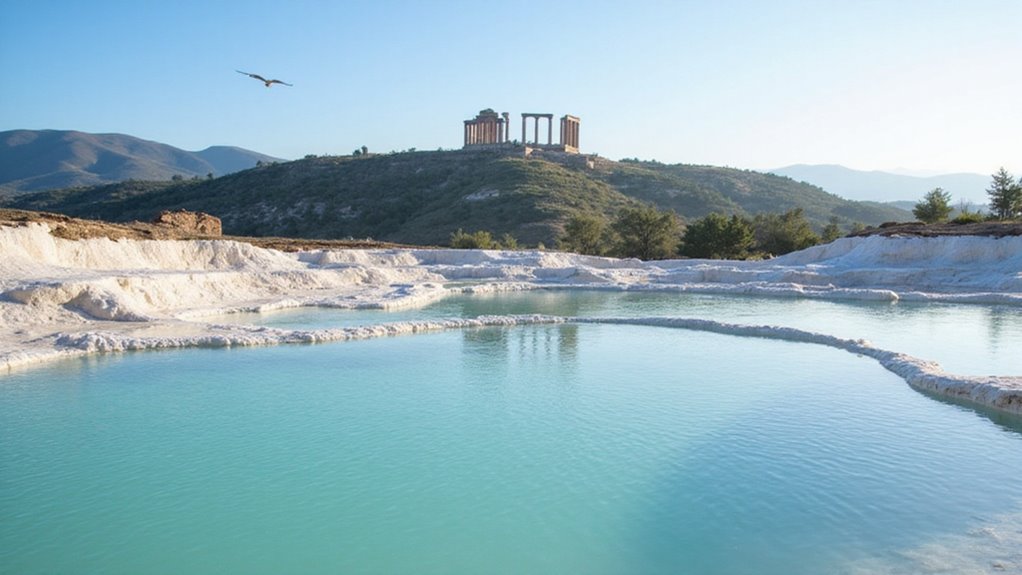
While Pamukkale’s thermal pools are a must-see, the surrounding region offers equally enchanting experiences.
Hierapolis, an ancient city perched above the pools, invites you to explore its well-preserved ruins, including a grand theater and the haunting Necropolis.
Just a short drive away, the travertine terraces of Karahayıt dazzle with their vibrant red and green hues, a striking contrast to Pamukkale’s white cascades.
For a taste of local cuisine, visit nearby Denizli, where you can savor traditional dishes like keşkek and gözleme in bustling Grand Bazaar-like markets.
Nature lovers shouldn’t miss the stunning Kaklık Cave, a hidden gem with its own thermal waters and unique rock formations.
The lush Çal Vineyards, perfect for a leisurely stroll, offer a serene escape. For those seeking adventure, consider a day trip to Sapanca Lake, known for its clear turquoise waters and tranquil environment.
These natural wonders and cultural treasures guarantee your journey beyond the pools is as unforgettable as the destination itself.
Health Benefits of the Thermal Waters
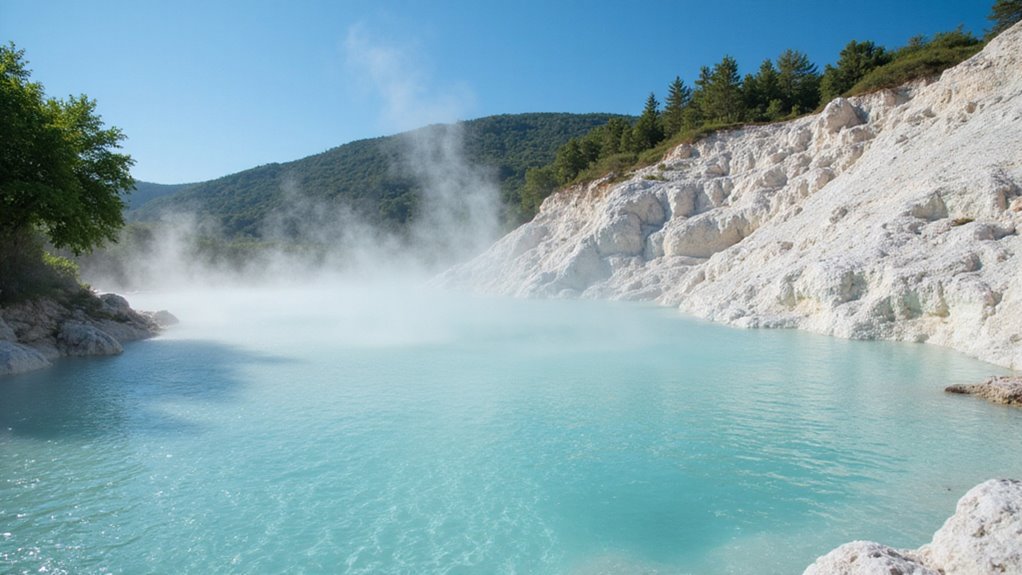
Beyond the natural beauty and cultural sights, the thermal waters of Pamukkale offer more than relaxation. The pools’ unique water composition, rich in calcium, magnesium, and bicarbonate, provides natural healing for your body. Soaking in these mineral-rich waters can soothe muscle aches, improve circulation, and even alleviate skin conditions like eczema.
The warm temperature, averaging 35°C, helps ease joint pain, making it ideal for those with arthritis or chronic inflammation. Pamukkale’s terraces, formed by centuries of flowing thermal springs, create a serene environment where you can unwind while benefiting from nature’s remedies. For a similar escape, consider exploring the fairy chimneys in Cappadocia, which offer a unique blend of natural beauty and ancient history.
The alkaline pH of the water promotes detoxification, leaving your skin refreshed and rejuvenated. Whether you’re seeking relief from stress or physical ailments, these waters offer a holistic escape. Embrace the freedom to heal naturally as you immerse yourself in one of the world’s most therapeutic landscapes. Let the minerals work their magic while you soak in the breathtaking views. For a deeper cultural experience, consider exploring historical landmarks like Hagia Sophia and Topkapi Palace in Istanbul, which complement the natural wonders of Pamukkale.
Tips for a Safe and Enjoyable Experience
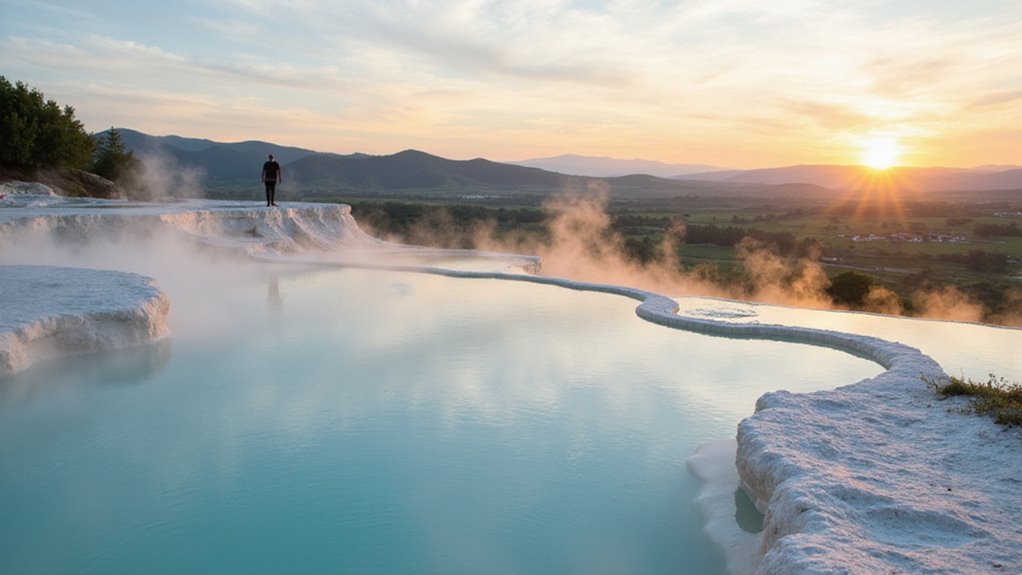
Visiting the thermal pools of Pamukkale can be a magical experience, but planning ahead guarantees you’ll make the most of it. Start by checking the weather and wearing comfortable, non-slip footwear to navigate the travertine terraces safely. For an added thrill, consider a microlight flight over Cappadocia to witness breathtaking aerial views of the region. If you prefer a more serene experience, a hot air balloon ride at sunrise offers unparalleled views of the landscape.
Follow safety precautions by staying hydrated, avoiding prolonged exposure to the hot springs, and heeding posted warnings. Respect visitor etiquette by not using soap or lotions in the pools, as they can harm the natural ecosystem.
Arrive early to avoid crowds and enjoy the serene, milky-white waters in peace. Bring a waterproof bag for your belongings and a towel for drying off. Don’t forget sunscreen, as the sun can be intense.
Capture stunning photos but avoid stepping on fragile formations. Pamukkale’s beauty is best enjoyed when you’re mindful of its preservation.
Frequently Asked Questions
Can I Swim in the Pamukkale Thermal Pools?
You can’t swim in the main terraces, but you’ll find designated areas nearby. Follow swimming regulations to protect the pools’ natural beauty. Prioritize thermal pool safety; watch your step and avoid hot spots for a worry-free experience.
Are the Thermal Pools Open Year-Round?
The thermal pools are open year-round, but seasonal changes can affect your visit. You’ll find warmer, less crowded experiences in winter, while summer offers vibrant energy. Plan ahead to enjoy the freedom of exploring whenever you choose.
Is There a Dress Code for Visiting the Pools?
Ever wondered if rules tame adventure? There’s no strict dress code, but dress code etiquette suggests modest, appropriate swimwear. You’re free to soak, but remember—comfort and respect let you enjoy nature’s embrace without restrictions. Just plunge in!
Are the Thermal Pools Wheelchair Accessible?
While wheelchair accessibility varies, you’ll find some areas with mobility assistance at the thermal pools. Durable paths and ramps are available in certain spots, but uneven terrain might limit full access. Plan ahead for your comfort.
Can I Bring Food and Drinks Into the Pools Area?
You can’t bring food to the pools—it’s a hard rule. But don’t worry, there are picnic areas nearby where you can feast like kings. Food regulations keep the waters pristine, so pack snacks for those spots instead.


